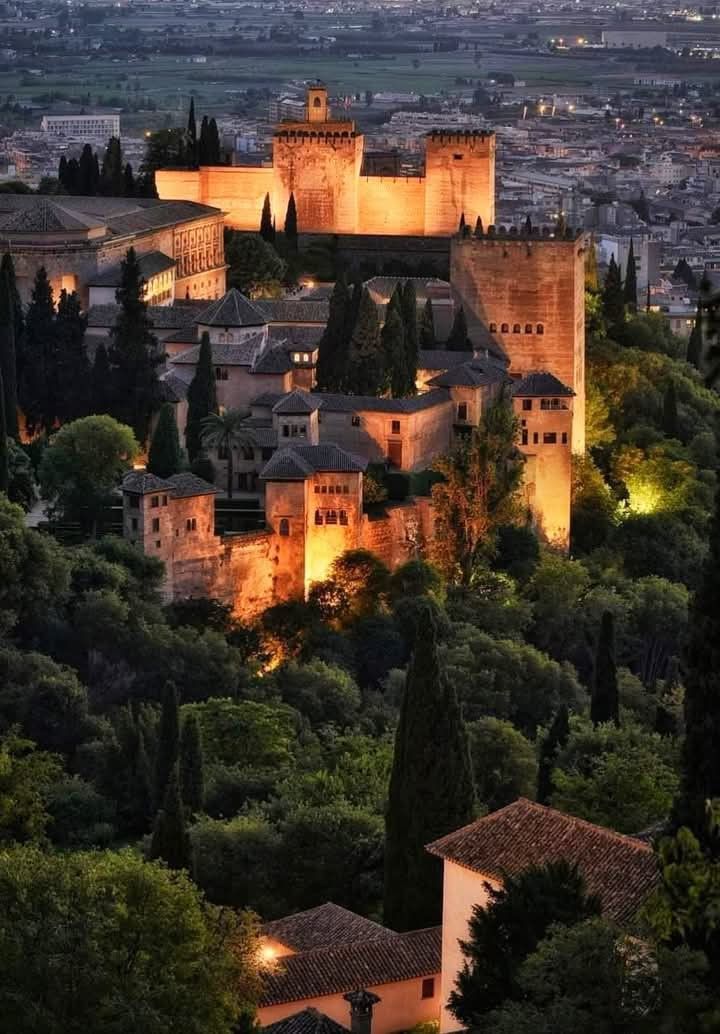The Alhambra, Spain: A Majestic Symbol of Moorish Legacy
The Alhambra stands as one of the most iconic and breathtaking historical landmarks in Spain. Situated in the city of Granada, this fortress-palace complex offers a stunning glimpse into the grandeur and sophistication of Moorish architecture and culture. With its intricate designs, lush gardens, and awe-inspiring views, the Alhambra continues to captivate visitors from around the world. Its rich history, magnificent structures, and cultural significance make it not just a symbol of Spanish heritage but also a testament to the lasting influence of Islamic art and architecture.
History
It’s history dates back to the 9th century, but it was during the 13th century under the reign of Muhammad I of the Nasrid Dynasty that the Alhambra began to take its present form. The Nasrid rulers, the last Muslim dynasty in Spain, transformed what was initially a modest military fortress into an elaborate palace complex, complete with gardens, courtyards, and splendid Islamic architecture.
The name “Alhambra” is derived from the Arabic term “Al-Qal’a al-Hamra”, meaning “The Red Fortress,” which refers to the reddish hue of the walls made from local clay. Over the centuries, the palace underwent several expansions and enhancements, with each ruler adding their own architectural and decorative flourishes, turning the Alhambra into a masterpiece of Islamic art and design.
The Alhambra remained under Muslim rule until 1492, when it was captured by Ferdinand and Isabella during the Reconquista, the Christian reconquest of Spain. After the conquest, the complex became the royal residence of the Catholic Monarchs, and it continued to hold significant cultural and political value.
Architectural Features
It is renowned for its Moorish architecture, which blends Islamic, Christian, and Jewish influences. The intricate design elements, innovative use of water, and stunning gardens make it one of the most important architectural monuments in the world. Some of its most notable features include:
- The Nasrid Palaces: The Nasrid Palaces are the heart of the Alhambra and feature some of the most exquisite Islamic architecture ever created. The palaces are divided into multiple sections, such as the Mexuar Hall, the Comares Palace, and the Palace of the Lions. These rooms are decorated with stucco reliefs, intricate tile work, muqarnas ceilings, and arabesque patterns, showcasing the fine craftsmanship of the era.
- The Courtyard of the Lions: One of the most famous spaces within the Alhambra is the Courtyard of the Lions, a stunning courtyard surrounded by 12 marble lions that spout water into a central fountain. The courtyard, with its detailed tile work, columns, and arches, is an example of the perfect symmetry and beauty found throughout the Alhambra.
- The Alhambra Gardens: The gardens of the Alhambra are just as impressive as its palaces. The Generalife, a summer palace and gardens, was created as a retreat for the royal family. The gardens are designed with fountains, pools, and lush vegetation, incorporating water as a key element in both design and symbolism.
- The Alcazaba: The Alcazaba is the oldest part of the Alhambra, serving as a military fortress with towering walls and defensive structures. The fortress provided the complex with protection and allowed the Nasrid rulers to have a commanding view of the surrounding city of Granada. The watchtower of the Alcazaba offers breathtaking panoramic views of the city and the Sierra Nevada Mountains.
- The Water Features: The use of water in the Alhambra is one of its defining characteristics. From cascading fountains to pools and channels, water was not just a practical element but also a symbol of life and purity in Islamic culture. The Patio de los Arrayanes (Court of the Myrtles) and the Fountain of the Lions are perfect examples of how water was incorporated into the palace’s design.
Significance
It is a reflection of the cultural, artistic, and architectural achievements of the Nasrid Dynasty and Islamic Spain. Its historical and cultural significance extends beyond its stunning beauty, making it a key symbol of both Spain’s Islamic heritage and the cultural melting pot that existed in Granada for centuries.
- Symbol of Islamic Art and Architecture: The Alhambra is one of the finest examples of Islamic architecture in the world. Its design emphasizes symmetry, intricate decoration, and a deep connection to nature. The stunning geometric patterns, delicate stucco work, and elaborate tile mosaics all reflect the values of beauty, spirituality, and harmony found in Islamic art.
- A Monument of Cultural Fusion: The Alhambra is a symbol of the cultural fusion between Muslim, Christian, and Jewish traditions during the medieval period. The architectural style reflects this blend, with elements of Gothic, Renaissance, and Jewish influences integrated into the design.
- Historical Significance: The Alhambra has witnessed significant events in Spanish history, including the fall of the Nasrid Kingdom and the end of Muslim rule in Spain. Its capture in 1492 marked the completion of the Reconquista and the consolidation of Christian rule over Spain.
- A UNESCO World Heritage Site: In 1984, the Alhambra was declared a UNESCO World Heritage Site due to its outstanding universal value as a cultural and architectural masterpiece. It is one of Spain’s most visited tourist attractions and an enduring symbol of the country’s rich history.
Key Facts
- The Alhambra Complex: It is not just a single building but a vast complex that includes palaces, fortresses, gardens, and courtyards. It covers an area of around 142,000 square meters (over 35 acres).
- Intricate Tile Work and Stucco: The Alhambra is famous for its decorative tile work, stucco designs, and arabesque motifs that adorn the walls and ceilings. The intricate detailing showcases the high level of craftsmanship and artistry that went into its creation.
- The Lion Fountain: The Fountain of the Lions in the Palace of the Lions is one of the most iconic features of the Alhambra. It is supported by 12 marble lions, each symbolizing a different quality, and serves as a symbol of both power and tranquility.
- Generalife Gardens: The Generalife was the summer palace and gardens of the Nasrid rulers. Its lush vegetation, fountains, and pathways make it a serene escape from the more formal settings of the palace.
- The Alhambra’s Influence on Art: It has had a lasting impact on the world of art and design. Its architectural style has inspired numerous artists, architects, and designers over the centuries, including the famous painter Washington Irving, who wrote a book about the Alhambra that introduced the palace to a wider audience.
- The Alhambra’s Restoration: Over the years, the Alhambra has undergone several restoration efforts to preserve its grandeur. These efforts continue today to ensure that future generations can appreciate its beauty and historical importance.
- Visitor Attraction: It attracts more than 2 million visitors annually, making it one of Spain’s top tourist destinations. The combination of its breathtaking architecture, historical significance, and scenic surroundings makes it a must-see for travelers.
Impact on Society and Tourism
It has left a lasting legacy on both Spanish culture and the global appreciation of Islamic art and architecture. As a UNESCO World Heritage Site, it continues to serve as a major cultural and tourist attraction, drawing people from all over the world to marvel at its beauty, history, and artistic achievements.
Its preservation allows visitors to explore the unique blend of Islamic, Christian, and Jewish influences that shaped the history of Spain, while offering a glimpse into the sophisticated lifestyle of the Nasrid dynasty. The Alhambra remains a symbol of Spain’s diverse and complex past, offering a bridge between different cultures and a testament to the power of architectural innovation.
Conclusion: A Jewel of Islamic Heritage
It stands as a timeless masterpiece of architecture, art, and history. From its serene gardens to its intricate palaces, the Alhambra continues to captivate visitors and scholars alike with its rich cultural heritage. As one of Spain’s most iconic landmarks, it remains a symbol of the country’s diverse and intertwined history, representing the enduring legacy of the Moorish civilization and its profound influence on the world.










